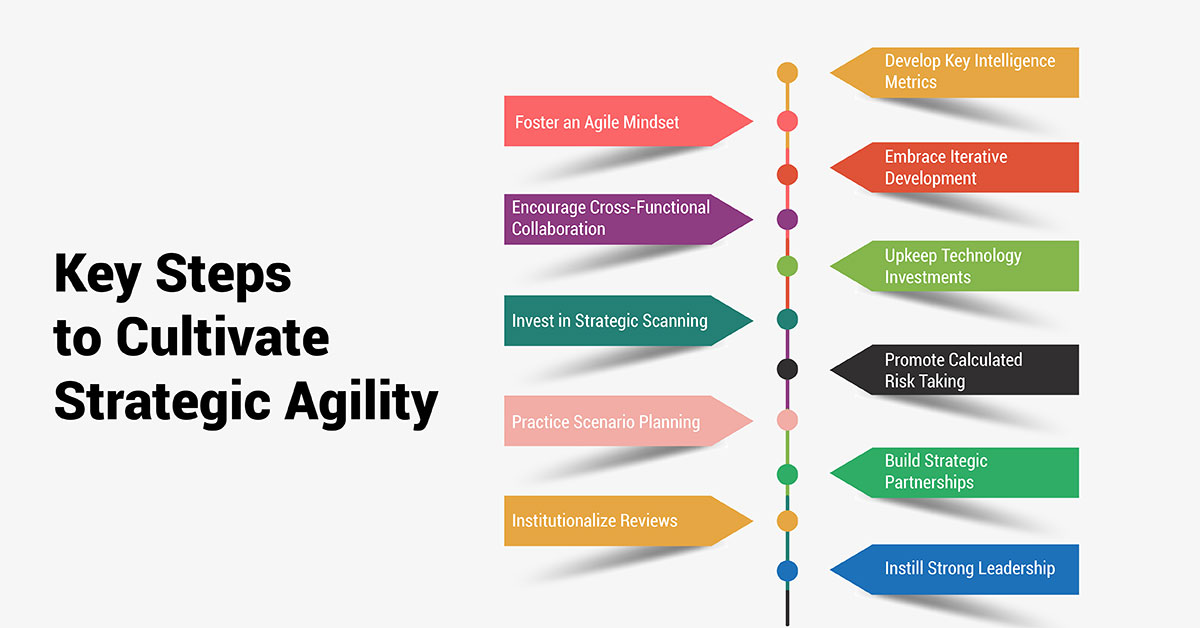Mastering Strategic Agility for Continuous Business Evolution
 November 20, 2024
November 20, 2024
In today’s fast-paced and disruptive business landscape, maintaining a balance between stability and flexibility is crucial for long-term success. Organizations must provide clear direction while adapting quickly to changing circumstances. Achieving this balance requires cultivating strategic agility—the ability to swiftly recalibrate strategies in response to shifts while maintaining a cohesive vision.
For business leaders and strategy professionals, fostering strategic agility is essential. This capability enables companies to chart a steady course for the future and maneuver effectively when faced with unexpected challenges. However, achieving true strategic agility demands foresight, meticulous planning, and an agile mindset throughout the organization.
This article explores how organizations can balance stability and flexibility through strategic agility. It will define strategic agility, examine its significance in today’s context, and offer practical recommendations for cultivating it to ensure sustainable business growth.
Understanding Strategic Agility
At its core, strategic agility refers to an organization’s ability to adapt its strategies and plans in a timely, coherent manner to changing circumstances while staying aligned with its long-term vision and goals. It involves three key pillars:
Sense: The ability to scan the business environment continuously and identify potential threats, opportunities or weak signals early. This helps organizations stay aware of shifting trends and emerging challenges/possibilities.
Respond: Having the dexterity to recalibrate strategies, resource allocation, processes or structures seamlessly in response to the sensed changes. This allows adjustments to be made urgently when required.
Stability: Upholding the overarching vision, values, culture and strategic direction despite changes. This anchors the organization and provides consistent long-term guidance even during disruptions.
Through integrating these three elements, this business strategy helps strike a judicious balance between stability and flexibility. It empowers organizations to steadily chart their long-term course while maintaining the maneuverability to navigate challenges and capitalize on opportunities along the way.
Importance of Strategic Agility Today
The contemporary business environment is characterized by volatility, uncertainty, complexity and ambiguity at an unprecedented level. Disruptive technologies, evolving consumer behavior, geopolitical turbulence and other macro forces are reshaping industries constantly.
Amid such flux, maintaining a single static strategy is untenable. Ongoing changes around organizations occur at an accelerated pace, and the half-life of strategies keeps declining. Those sticking rigidly to predefined plans, without scope for recalibration, are at high risk of being left behind.
Strategic agility, then, has become absolutely critical for staying competitive in current times. It offers three key advantages that enable organizations to thrive amid the disruption:
-
1.
Risk Mitigation
By continuously tracking market and industry trends, strategic agility helps companies detect shifts and changes as they emerge. This early detection allows them to anticipate possible risks and challenges these shifts may pose.
They can then develop contingency plans to deal with different scenarios that may arise due to these risks. When needed, companies with strategic agility can quickly pivot and implement these contingency plans to minimize negative impacts.
For example, by closely monitoring supply chain issues, a manufacturing company is able to foresee supply disruptions during the pandemic. It has backup plans to avoid production halts and reduce the financial risks when disruptions actually occur.
-
2.
Opportunity Pursuit
Agile companies are swift in recognizing opportunities amid changes and uncertainties. They are responsive to capture benefits from new opportunities as they appear.
For instance, a food delivery startup can leverage its strategic agility to capitalize on the boom in its sector during lockdowns. It swiftly scales operations and expands into new areas. This helps clock high growth and boost its market position.
-
3.
Future Proofing
While being responsive, strategically agile companies also have a stable long term strategic vision. Their strategies are anchored to this vision but allow flexibility in plans and roadmaps.
This balanced approach helps future proof businesses. Though adaptive to changes, companies retain focus on their long term goals. Even during disruptions like the pandemic, they could adjust tactics but didn’t lose sight of their long term objectives.
By evaluating different future scenarios and maintaining optionality, agile strategies safeguard firms from unpredictable future developments. They are prepared to gradually modify the course of action if the reality unfolds differently than anticipated plans.
As volatility becomes the new normal, strategic agility represents a distinct competitive advantage. Those cultivating it are better positioned for resilience as well as performance in today’s dynamic marketplace.
Key Steps to Cultivate Strategic Agility
Achieving true strategic agility requires a conscious effort across people, processes, culture and technology dimensions. Business leaders must shape an environment conducive for its cultivation. Some key recommendations include:

-
Foster an Agile Mindset
Strategic agility begins from within. Leaders must role model and promote an open, learning-oriented mindset appreciative of change. This forms the foundation for an agile culture. Techniques like mentoring, coaching and growth opportunities can instill such mindsets.
-
Encourage Cross-Functional Collaboration
Creating cross-functional, fluid teams brings diverse perspectives together, improving sensing abilities. Their collaboration also expedites responsive decision making. Leaders must incentivize collaboration across silos.
-
Invest in Strategic Scanning
Leveraging tools, AI and external networks enhances environmental scanning abilities. Constantly monitoring weak signals and trends aids early identification of challenges and opportunities. Budgeting for such scanning is important.
-
Practice Scenario Planning
Developing informed yet flexible scenarios accounting for uncertainties, instead of fixed forecasts, leaves room for maneuver amid disruptions. Conduct scenario planning exercises regularly.
-
Institutionalize Reviews
Formal reviews of strategies, plans and performance checkpoints at set intervals (quarterly/half-yearly) and during disruptions helps maintain a dynamic approach. Institutionalize such reviews.
-
Develop Key Intelligence Metrics
Identifying and tracking key metrics not just on outcomes but also scanning, responsiveness and stability parameters helps assess agility levels objectively and pinpoint areas for improvement.
-
Embrace Iterative Development
Instead of the traditional waterfall approach, iterative, agile methodology leveraging minimum viable products and constant feedback facilitates flexible response. Allow experiments.
-
Upkeep Technology Investments
Strategic agility is technology-dependent today. Ongoing investments in digital transformation, business analytics, cloud infrastructure and collaboration platforms equip the organization with the means to sense and respond adeptly.
-
Promote Calculated Risk Taking
Permission to experiment, challenge conventions and take measured risks in decision making spreads innovation and fosters a learning attitude assisting agility. Recognize failures as learning lessons.
-
Build Strategic Partnerships
Collaborations augment capabilities, reduce uncertainties and quicken responses. Partners may be customers, suppliers, governments, universities or competitors on non-competitive issues. Build diverse networks.
-
Instill Strong Leadership
Most importantly, agility needs champions. Leaders must role model agility through curiosity, adaptability and empowering autonomy. Their clarity of vision yet flexibility in implementation inspires the whole organization in its agility journey.
Case studies in organizations like Amazon demonstrate how those excelling in agility relentlessly focused on these aspects to optimize balance between stability and flexibility. Cultivating a similar ethos requires persistent work but massively benefits organizations in rapidly changing contexts.
What Steps are Needed for Sustaining Agility?
While kickstarting the transformation forms a major milestone, sustaining strategic agility remains an ongoing undertaking. Leaders must institutionalize agility into the organizational DNA through:
-
Reward and Recognition: Recognizing agility efforts, accomplishments and innovation appropriately through rewards and acknowledgements motivates the workforce in maintaining agility as business-as-usual.
-
Communications: Consistent communication by leaders highlighting agility principles, progress and goal setting aids awareness and buy-in at all levels and sustains momentum.
-
Training and Development: Continuous learning opportunities aid employees in staying upskilled with changing market needs and enhance senses, decision making and responsive capabilities over time.
-
Measurement and Feedback: Periodic measurement of agility metrics and qualitative feedback reviews performance, strengths, gaps and lessons. This drives improvements.
-
Benchmarking: Benchmarking against best-in-class organizations stimulates competitive spirit and ushers in progress via cross-learnings. External perspectives aid course corrections.
-
Crisis Preparedness: Simulated agility “war games” planned occasionally help crisis-proof strategies and responsiveness via lessons during disruptive situations that may arise.
-
Culture Assimilation: Inculcating agility into strong cultural traits over the long run through rituals, stories and symbols embeds it indelibly into the organizational DNA.
Strategic reviews during disruptions further exemplify agility and strengthen sustainability. With persistent effort, organizations can optimize the precarious balance between stability and flexibility to strengthen future-readiness through strategic agility.
Conclusion
In conclusion, the disruptive business environment calls for a new strategic aptitude that can effectively navigate the fluid landscape - strategic agility. By cultivating capabilities to continually sense shifts, respond adeptly yet retain a steady vision, organizations future-proof their strategies. For business leaders, the emphasis is on fostering this critical competency through ingraining an agile mindset and enabling mechanisms organization-wide. This approach harnesses the immense power of strategic agility to optimize both current operations and future opportunities.


